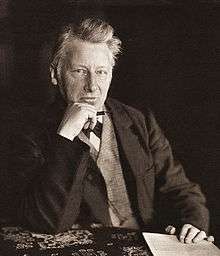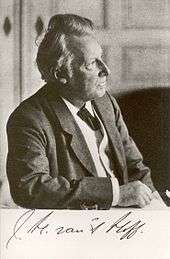Jacobus Henricus van 't Hoff
| Jacobus Henricus van 't Hoff, Jr. | |
|---|---|
 van 't Hoff by Nicola Perscheid in 1904 | |
| Born |
30 August 1852 Rotterdam, Netherlands |
| Died |
1 March 1911 (aged 58) Steglitz near Berlin, German Empire |
| Residence |
Netherlands German Empire |
| Nationality | Dutch |
| Fields |
Physical chemistry Organic chemistry Theoretical chemistry |
| Institutions |
|
| Alma mater | |
| Doctoral advisor | Eduard Mulder |
| Doctoral students | Ernst Cohen |
| Other notable students | Frederick G. Donnan |
| Known for |
|
| Notable awards |
|
Jacobus Henricus van 't Hoff, Jr. (Dutch pronunciation: [vɑn(ə)t ˈɦɔf]; 30 August 1852 – 1 March 1911) was a Dutch physical chemist. A highly influential theoretical chemist of his time, van 't Hoff was the first winner of the Nobel Prize in Chemistry.[2][3][4] His pioneering work helped found the modern theory of chemical affinity, chemical equilibrium, chemical kinetics, and chemical thermodynamics. In his 1874 pamphlet Van 't Hoff formulated the theory of the tetrahedral carbon atom and laid the foundations of stereochemistry. In 1875, he predicted the correct structures of allenes and cumulenes as well as their axial chirality.[5] He is also widely considered one of the founders of physical chemistry as the discipline is known today.[6][7][8]
Biography
The third of seven children, Van 't Hoff was born in Rotterdam, Netherlands, 30 August 1852. His father was Jacobus Henricus van 't Hoff, Sr., a physician, and his mother was Alida Kolff van 't Hoff.[9] From a young age, he was interested in science and nature, and frequently took part in botanical excursions. In his early school years, he showed a strong interest in poetry and philosophy. He considered Lord Byron to be his idol.
Against the wishes of his father, Van 't Hoff chose to study chemistry. First, he enrolled at Delft University of Technology in September 1869, and studied until 1871, when he passed his final exam on at 8 July and obtained a degree of chemical technologist.[10][11][12] He passed all his courses in two years, although the time assigned to study was three years.[10][11][12] Then he enrolled at University of Leiden to study chemistry. He then studied in Bonn, Germany, with Friedrich Kekulé and in Paris with C. A. Wurtz. He received his doctorate under Eduard Mulder at the University of Utrecht in 1874.[13]
In 1878, Van 't Hoff married Johanna Francina Mees. They had two daughters, Johanna Francina (b. 1880) and Aleida Jacoba (b. 1882), and two sons, Jacobus Henricus van 't Hoff III (b. 1883) and Govert Jacob (b. 1889). Van 't Hoff died at the age of 58, on 1 March 1911, at Steglitz, near Berlin, from tuberculosis.
Career

Van 't Hoff earned his earliest reputation in the field of organic chemistry. In 1874, he accounted for the phenomenon of optical activity by assuming that the chemical bonds between carbon atoms and their neighbors were directed towards the corners of a regular tetrahedron.[14][15] This three-dimensional structure accounted for the isomers found in nature. He shares credit for this with the French chemist Joseph Le Bel, who independently came up with the same idea.
Three months before his doctoral degree was awarded Van 't Hoff published this theory, which today is regarded as the foundation of stereochemistry, first in a Dutch pamphlet in the fall of 1874, and then in the following May in a small French book entitled La chimie dans l'espace. A German translation appeared in 1877, at a time when the only job van 't Hoff could find was at the Veterinary School in Utrecht. In these early years his theory was largely ignored by the scientific community, and was sharply criticized by one prominent chemist, Hermann Kolbe. Kolbe wrote:
"A Dr. J. H. van ’t Hoff of the Veterinary School at Utrecht has no liking, apparently, for exact chemical investigation. He has considered it more convenient to mount Pegasus (apparently borrowed from the Veterinary School) and to proclaim in his ‘La chimie dans l’espace’ how, in his bold flight to the top of the chemical Parnassus, the atoms appeared to him to be arranged in cosmic space."
However, by about 1880 support for van 't Hoff's theory by such important chemists as Johannes Wislicenus and Viktor Meyer brought recognition.
In 1884, Van 't Hoff published his research on chemical kinetics, titled Études de Dynamique chimique ("Studies in Chemical Dynamics"), in which he described a new method for determining the order of a reaction using graphics and applied the laws of thermodynamics to chemical equilibria. He also introduced the modern concept of chemical affinity. In 1886, he showed a similarity between the behaviour of dilute solutions and gases. In 1887, he and German chemist Wilhelm Ostwald founded an influential scientific magazine named Zeitschrift für physikalische Chemie ("Journal of Physical Chemistry"). He worked on Svante Arrhenius's theory of the dissociation of electrolytes and in 1889 provided physical justification for the Arrhenius equation. In 1896, he became a professor at the Prussian Academy of Sciences in Berlin. His studies of the salt deposits at Stassfurt were an important contribution to Prussia's chemical industry.
Van 't Hoff became a lecturer in chemistry and physics at the Veterinary College in Utrecht. He then worked as a professor of chemistry, mineralogy, and geology at the University of Amsterdam for almost 18 years before eventually becoming the chairman of the chemistry department. In 1896, Van 't Hoff moved to Germany, where he finished his career at the University of Berlin in 1911. In 1901, he received the first Nobel Prize in Chemistry for his work with solutions. His work showed that very dilute solutions follow mathematical laws that closely resemble the laws describing the behavior of gases.
Honours and awards
In 1885, Van 't Hoff was appointed as a member of the Royal Netherlands Academy of Sciences.[16] Other distinctions include honorary doctorates from Harvard and Yale (1901), Victoria University, the University of Manchester (1903), and University of Heidelberg (1908). He was awarded the Davy Medal of the Royal Society in 1893 (along with Le Bel), and elected a Foreign Member of the Royal Society (ForMemRS) in 1897. He was awarded the Helmholtz Medal of the Prussian Academy of Sciences (1911) and appointed Chevalier de la Légion d'honneur (1894) and Senator der Kaiser-Wilhelm-Gesellschaft (1911). Van 't Hoff became an honorary member of the British Chemical Society in London, the Royal Dutch Academy of Sciences (1892), American Chemical Society (1898), and the Académie des Sciences, in Paris (1905). Of his numerous distinctions, Van 't Hoff regarded winning the first Nobel Prize in Chemistry as the culmination of his career. The following are named after him:
References
- ↑ "Fellows of the Royal Society". London: Royal Society. Archived from the original on 16 March 2015.
- ↑
 Chisholm, Hugh, ed. (1911). "van't Hoff, Jacobus Hendricus". Encyclopædia Britannica (11th ed.). Cambridge University Press.
Chisholm, Hugh, ed. (1911). "van't Hoff, Jacobus Hendricus". Encyclopædia Britannica (11th ed.). Cambridge University Press. - ↑ Nobel Lecture Osmotic Pressure and Chemical Equilibrium from Nobelprize.org website
- ↑ Karl Grandin, ed. "Jacobus Henricus van 't Hoff Biography". Les Prix Nobel. The Nobel Foundation. Retrieved 15 August 2008.
- ↑ La Chemie dans l'Espace, Bazendijk: Rotterdam, 1875
- ↑ Meijer, E. W. (2001). "Jacobus Henricus van 't Hoff; Hundred Years of Impact on Stereochemistry in the Netherlands". Angewandte Chemie International Edition. 40 (20): 3783–3789. PMID 11668534. doi:10.1002/1521-3773(20011015)40:20<3783::AID-ANIE3783>3.0.CO;2-J.
- ↑ Spek, Trienke M. van der (2006). "Selling a Theory: The Role of Molecular Models in J. H. van 't Hoff's Stereochemistry Theory". Annals of Science. 63 (2): 157. doi:10.1080/00033790500480816.
- ↑ Kreuzfeld, HJ; Hateley, MJ. (1999). "125 years of enantiomers: back to the roots Jacobus Henricus van 't Hoff 1852–1911". Enantiomer. 4 (6): 491–6. PMID 10672458.
- ↑ Biography on Nobel prize website. Nobelprize.org (1 March 1911). Retrieved on 2011-08-12.
- 1 2 H.A.M., Snelders (1993). De geschiedenis van de scheikunde in Nederland. Deel 1: Van alchemie tot chemie en chemische industrie rond 1900. Delftse Universitaire Pers.
- 1 2 Cordfunke, E. H. P. (2001). Een romantisch geleerde: Jacobus Henricus van 't Hoff (1852–1911). Vossiuspers UvA.
- 1 2 Cohen, E. (1899). Jacobus Henricus van't Hoff. Verlag von Wilhelm Engelmann.
- ↑ Entry in Digital Album Promotorum of Utrecht University
- ↑
- Van 't Hoff (3 September 1874) Voorstel tot Uitbreiding der Tegenwoordige in de Scheikunde gebruikte Structuurformules in de Ruimte, benevens een daarmee samenhangende Opmerking omtrent het Verband tusschen Optisch Actief Vermogen en chemische Constitutie van Organische Verbindingen (Proposal for the Extension of Current Chemical Structural Formulas into Space, together with Related Observation on the Connection between Optically Active Power and the Chemical Constitution of Organic Compounds) [pamphlet published by the author]. Available in English at: ChemTeam.
- Reprinted in French in: J.H. van 't Hoff (1874) "Sur les formules de structure dans l'espace," Archives neerlandaises des sciences exactes et naturelles, 9:445–454.
- ↑ Planar Methane – Periodic Table of Videos. YouTube. Retrieved on 30 December 2015.
- ↑ "Jacobus Hendrik van ‘t Hoff (1852–1911)". Royal Netherlands Academy of Arts and Sciences. Retrieved 17 July 2015.
Further reading
| Wikimedia Commons has media related to Jacobus van 't Hoff. |
- Patrick Coffey, Cathedrals of Science: The Personalities and Rivalries That Made Modern Chemistry, Oxford University Press, 2008. ISBN 978-0-19-532134-0
- Hornix WJ, Mannaerts SHWM, van 't Hoff and the emergence of Chemical Thermodynamics, Delft University Press, 2001, ISBN 90-407-2259-5
-
 Works written by or about Jacobus Henricus van 't Hoff at Wikisource
Works written by or about Jacobus Henricus van 't Hoff at Wikisource
